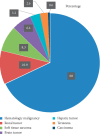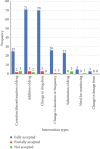Identification and Resolution of Drug-Related Problems among Childhood Cancer Patients in Ethiopia
- PMID: 32256586
- PMCID: PMC7102482
- DOI: 10.1155/2020/6785835
Identification and Resolution of Drug-Related Problems among Childhood Cancer Patients in Ethiopia
Abstract
Background: Even though medications play a major role in the cure, palliation, and inhibition of disease, they also expose patients to drug-related problems. Drug-related problems are frequent and may result in reduced quality of life, morbidity, and mortality.
Objectives: The study was aimed to identify, characterize, and resolve drug-related problems in the Pediatric Hematology/Oncology ward of Tikur Anbessa Specialized Hospital, Addis Ababa, Ethiopia.
Methods: A prospective observational study was conducted from 25 June to 25 October 2018 to assess DRPs on patients admitted at the pediatric hematology/oncology ward of Tikur Anbessa Specialized Hospital, which is the highest level governmental tertiary care hospital in Ethiopia. Data were obtained from patients' medical charts, physicians, patients/caregivers, pharmacists, and nurses. All the collected data were entered and analyzed using the Statistical Package for the Social Sciences version 25e. Descriptive statistics were used to represent the data.
Results: Among the total 156 participants, DRPs were identified in 68.6% of the study subjects. Dosing problems which include dosage too low and high were the top ranking (39.3%) of all DRPs followed by needs additional therapy (27.2%) and nonadherence (14.0%). Systemic anti-infectives were the most common class of drugs involved in DRPs. Trimethoprim-sulfamethoxazole, methotrexate, vincristine, ondansetron, and metoclopramide were frequently involved in DRPs. The addition of drugs and change in drug dose were the two most proposed intervention types. Among the proposed interventions, 223 (92.15%) were fully accepted, 9 (3.72%) partially accepted, and 10 (4.13%) not accepted.
Conclusion: DRPs are common among Pediatric Hematology/Oncology ward patients. The hospital should develop a pediatric dosing chart for the commonly prescribed medications to prevent drug-related morbidity and mortality. The integration of clinical pharmacists can mitigate risks associated with DRPs.
Copyright © 2020 Malede Berihun Yismaw et al.
Conflict of interest statement
The authors declare that they have no conflicts of interest.
Figures



Similar articles
-
Assessment of drug-related problems in pediatric ward of Zewditu Memorial Referral Hospital, Addis Ababa, Ethiopia.Int J Clin Pharm. 2017 Oct;39(5):1039-1046. doi: 10.1007/s11096-017-0504-9. Epub 2017 Jul 8. Int J Clin Pharm. 2017. PMID: 28689305 Free PMC article.
-
Drug-related problems in medical wards of Tikur Anbessa specialized hospital, Ethiopia.J Res Pharm Pract. 2015 Oct-Dec;4(4):216-21. doi: 10.4103/2279-042X.167048. J Res Pharm Pract. 2015. PMID: 26645029 Free PMC article.
-
Drug-related problems among medical ward patients in Jimma university specialized hospital, Southwest Ethiopia.J Res Pharm Pract. 2014 Jan;3(1):1-5. doi: 10.4103/2279-042X.132702. J Res Pharm Pract. 2014. PMID: 24991628 Free PMC article.
-
Drug-related problems identified by clinical pharmacists in an academic medical centre in Thailand.J Pharm Policy Pract. 2023 Dec 16;17(1):2288603. doi: 10.1080/20523211.2023.2288603. eCollection 2024. J Pharm Policy Pract. 2023. PMID: 38205196 Free PMC article.
-
Characteristic of drug-related problems and pharmacists' interventions in a stroke unit in Thailand.Int J Clin Pharm. 2019 Aug;41(4):880-887. doi: 10.1007/s11096-019-00832-4. Epub 2019 May 3. Int J Clin Pharm. 2019. PMID: 31054061
Cited by
-
Effect of Pharmacist-Led Interventions on Physicians' Prescribing for Pediatric Outpatients.Healthcare (Basel). 2022 Apr 18;10(4):751. doi: 10.3390/healthcare10040751. Healthcare (Basel). 2022. PMID: 35455928 Free PMC article.
-
Management Practice and Drug Related Problems and Its Contributing Factors Among Cervical Cancer Patients at Oncologic Center in Ethiopia: A Hospital-Based Retrospective Study.Ther Clin Risk Manag. 2022 Jun 10;18:643-655. doi: 10.2147/TCRM.S364923. eCollection 2022. Ther Clin Risk Manag. 2022. PMID: 35711253 Free PMC article.
-
Determinants of medication non-adherence among patients with chronic diseases at community pharmacy settings in South Gondar Zone, Northwest Ethiopia: a multicenter cross-sectional study.Front Public Health. 2024 Oct 18;12:1409153. doi: 10.3389/fpubh.2024.1409153. eCollection 2024. Front Public Health. 2024. PMID: 39494071 Free PMC article.
-
Investigating pediatric nurses' perceptions of factors contributing to MAEs at Yendi hospital, Ghana.BMC Pediatr. 2024 Dec 3;24(1):792. doi: 10.1186/s12887-024-05269-x. BMC Pediatr. 2024. PMID: 39627723 Free PMC article.
-
Adverse drug reactions and drug-related problems with supportive care medications among the oncological population.Discov Oncol. 2024 Sep 9;15(1):416. doi: 10.1007/s12672-024-01300-w. Discov Oncol. 2024. PMID: 39249610 Free PMC article.
References
-
- Alebachew A., Waddington C. Improving Health System Efficiency: Ethiopia: Human Resources for Health Reforms. Geneva, Switzerland: World Health Organization; 2015.
-
- Federal Ministry of Health (FMOH) Addis Ababa, Ethiopia: National Clinical Pharmacy Service Implementation Manual in Ethiopia; 2018.
-
- Fitzmaurice C., Akinyemiju T. F., Al Lami F. H., et al. Global, regional, and national cancer incidence, mortality, years of life lost, years lived with disability, and disability-adjusted life-years for 29 cancer groups, 1990 to 2016: a systematic analysis for the global burden of disease study. The Journal of the American Medical Association Oncology. 2018;4(11):1553–1568. doi: 10.1001/jamaoncol.2018.2706. - DOI - PMC - PubMed
LinkOut - more resources
Full Text Sources

